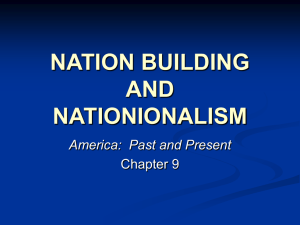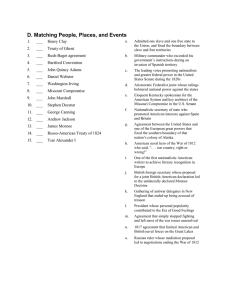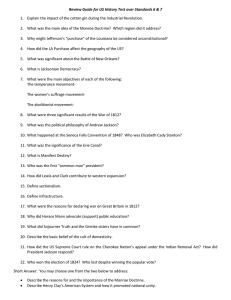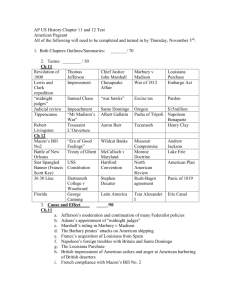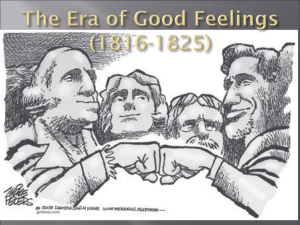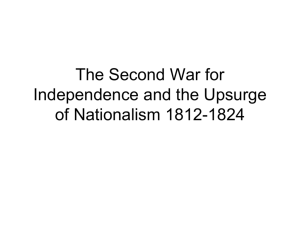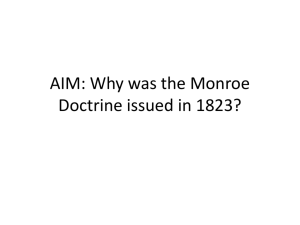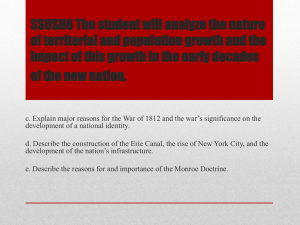CHAPTER 9 NATIONALISM AND NATION BUILDING
advertisement
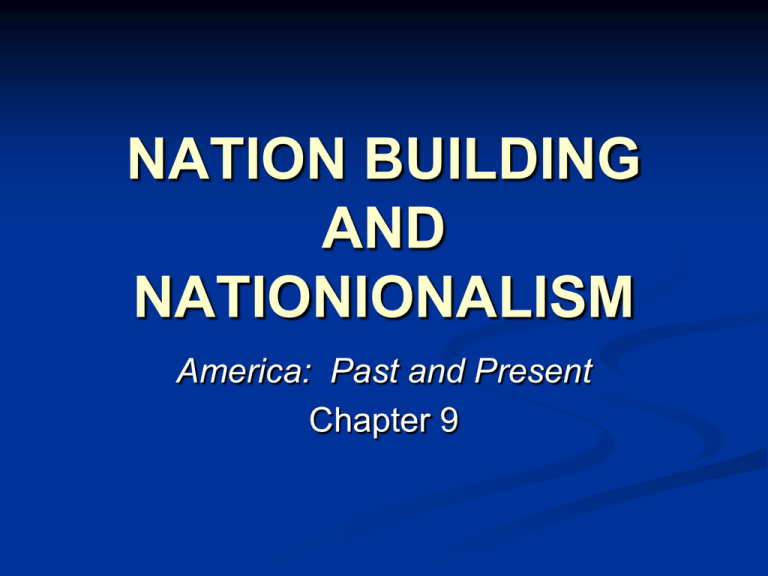
NATION BUILDING AND NATIONIONALISM America: Past and Present Chapter 9 Expansion and Migration American perspective shifts from Europe to West after 1815 Land perceived as rich, unsettled Continent held in part by the English, Spanish, and Indians Extending the Boundaries John Quincy Adams--expansionist secretary of state from 1816 to 1824 Florida 1st focus of post war expansionists Rush-Bagot, Convention of 1818 Andrew Jackson and 1st Seminole War Adams-Onis Treaty secures all Florida, U.S. boundary to Pacific Settled "West" still mostly east of Mississippi River John Jacob Astor, fur trade and backwoodsman American Fur Company Settlement to the Mississippi: Indian Removal Indian Removal policy begins after 1815 Some Indians retain tribal homelands (Cherokee largest of Five Civilized Tribes) Some Southern states claim jurisdiction over the Indians in their borders Former Indian land sold to speculators Trail of Tears Black Hawk War of 1832 Last resistance in old Northwest Settlement to the Mississippi: Settlers Move In By 1840 over 1/3 of U.S. population lives west of the Appalachians Speculators sell land parcels to settlers on credit Settlers immediately enter commercial farming to pay off debt Access to markets gained by network of market towns, regional centers The People and Culture of the Frontier West settled to escape overpopulation, rising land prices, worn-out soil Settlers bring culture with them Cooperation, strong community necessary for survival Land values rise rapidly in a few years Price rise encourages rootlessness as many sell out and move on A Revolution in Transportation Primitive land transportation in the East was offset by shipping via the coastal waterways After the War of 1812 political leaders recognized the need the need to improve the country’s transportation network President Madison referred to as “internal improvements” Roads National Road from Cumberland, Maryland to Wheeling, Virginia 1st great federal transportation project Private turnpikes built by entrepreneurs Roads useful but unprofitable Steamboats Network of rivers encourage economic developmen Flatboats transport down river early Steamboats transport upriver after 1811 Upriver capabilities reduce costs Steamboat traffic stimulates Congress to establish safety regulations Robert Fulton The Canal Boom Erie Canal first transportation link between East and West, 1825 (Albany to Buffalo) Most spectacular engineering achievement of young nation Canal cuts East-West transportation costs dramatically Canal stimulates commercial growth of New York City • Great canal building boom of 1820’s and 30’s ends because prove not to be profitable Emergence of a Market Economy Great national transportation system created by nation’s river network Canals cut shipping expenses for western farmers and eastern manufacturers Steamboats on the rivers also reduced shipping costs and stimulated commercial agriculture Economic revolution between 1810 and 1840 one of distribution rather than production The Beginning of Commercial Agriculture Lower transportation costs mean greater income for the farmer Sale to distant markets involves farmers in a complex system of credit Market stimulates specialization Ohio Valley produces wheat Lower South produces cotton (slavery, land, cotton gin, demand due to textile industry) Commerce and Banking Commercial farming stimulates new system of marketing Extension of credit crucial to development of agricultural marketing system Farmers borrow on future crops Farm subsidies due to demand for credit Use of credit stimulates banking State banks increase after 1812 1816--Second Bank of the United States created to check state banks Bank’s easy credit sparks Panic of 1819 1819 political cartoon • State banking systems and easy credit lead to frequent currency depreciations Early Industrialism Rise in manufacturing after 1812 Traditional methods but innovative financing through “putting out” system “putting-out”--merchants deliver raw materials for farm families, artisans to process Textile industry leads development of factory system, removal of production from home to factory Young single women primary labor source in textile mills Lowell, Massachusetts great showplace The Politics of Nation Building After the War of 1812 Politics a one-party system after 1812 Interest groups no longer take differences into the political arena Federal executive, legislature largely irrelevant to domestic economy Supreme Court exerts influence on economy by deciding crucial cases The Republicans in Power Republicans begin adopting Federalist measures after War of 1812 1815: establish high tariffs 1816: charter a national bank federal aid for internal improvements Federal efforts to stimulate economy falter Madison, Monroe see Constitutional conflicts Efforts provoke sectional conflict Henry Clay leading advocate for American System Monroe as President James Monroe elected President in 1816, reelected in 1820 Monroe seeks national harmony Takes no action in Panic of 1819, believes president above such matters Provides no leadership controversy over Missouri The Missouri Compromise: The Issues 1817--Missouri applies for statehood as slave state Northerners believe South overrepresented in House of Representatives House rejects unless slavery abolished South wishes to preserve balance between slave states and free states The Missouri Compromise: The Solution Missouri admitted as slave state Maine admitted as free state Slavery banned elsewhere in Louisiana Purchase above the latitude of 36E30' Missouri controversy exposed deep rift between North and South The Missouri Compromise, 1820-1821 Postwar Nationalism and the Supreme Court John Marshall chief justice 1801-1835 Marshall uses position to encourage national growth Believes Constitution exists to protect the industrious Protects individual property rights against government interference Marshall uses court decisions to limit powers of the states McCulloch v. Maryland – state can’t tax national bank Gibbons v. Ogden – federal regulation of interstate commerce Nationalism in Foreign Policy: The Monroe Doctrine Main diplomatic challenge – dealing with Latin American colonial revolts When Latin American nations revolt, U.S. supports new republics European ruling classes fear rebellion might prove contagious France was encouraged to squelch Spain's rebellious colonies Great Britain asks U.S. to cooperate against French in Latin America Nationalism in Foreign Policy: Monroe Doctrine (2) Monroe persuaded that U.S. alone must protect Latin American independence 1823--Monroe Doctrine warns European nations out of the Western Hemisphere Doctrine also promises U.S. will not interfere in European affairs Refocuses U.S. from worldwide struggles against tyranny to national development The Troubled Presidency of John Quincey Adams James Monroe supports John Quincy Adams to succeed him Adams intelligent, keen interest in progress, loyal to nation, not sectional Nearly loses election of 1824 A "gentleman" in an age of rising democracy Term of office fails because of fiercely contending sectional interests The End of the “Era of Good Feelings” There were sharp divisions over how to achieve national greatness Elite nonpartisan statesmanship would soon give way to a more contentious democratic process
